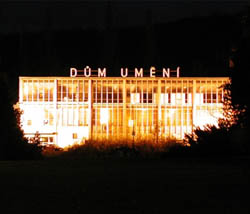
The Zlín City Hall is preparing a conference on the future of the Baťa Memorial
 |
The conference will also commemorate the 130th anniversary of Tomáš Baťa's birth; the founder of the shoe empire died in a plane crash in 1932. The city, together with the Tomáš Baťa Foundation, is preparing the conference for September and aims to invite prominent architects, such as Eva Jiřičná, who also designed the Congress and University Center for Zlín.
"Several versions of how to utilize the memorial will be discussed there. From the purest version, which returns to the original form with only a replica of the plane in which Baťa died in the memorial, to more complex proposals that consider, for example, the construction of new conference or archival spaces. Of course, we welcome any new suggestions," Ondrová stated.
The amount of investment in the reconstruction of the memorial will depend on the chosen option, with costs ranging from 20 to 100 million crowns, and the city hopes to utilize European resources. "That's also why we want to address the form of the object at the conference, so we can prepare for funding," the deputy noted.
In a few years, the city hall intends to relocate the Bohuslav Martinů Philharmonic from the House of Arts, which should have its new headquarters in the Congress and University Center that began construction this year. The regional gallery is expected to acquire new spaces in the former Baťa industrial complex.
The Baťa architecture in Zlín is also symbolized by Building 21 of the former industrial complex, known as the Baťa skyscraper, and typical Baťa houses. They formed entire neighborhoods that emerged in Zlín, particularly in the 1930s, for the housing of the workforce of the rapidly developing Baťa factories. A characteristic feature are the brick facades.
The Baťa houses make up the majority of the urban heritage zone defined by the city boundaries from 1939. It includes about 1,750 buildings in the areas of Letná, Lazy, Podvesná, Zálešná, Díly, and the industrial complex in the center of Zlín. Approximately 30,000 of the city's 78,000 inhabitants live in them.
The English translation is powered by AI tool. Switch to Czech to view the original text source.
2 comments
add comment
Subject
Author
Date
Baťův památník
Miroslav Šimůnek
16.03.06 09:20
baťův památník
Radovan Snopek
13.07.06 11:29
show all comments
Related articles
0
21.06.2017 | The region will repair the building of the former gate to the factory premises in Zlín
0
27.02.2017 | The builders have started to modify the Zlín Memorial of Tomáš Baťa from the outside
0
30.01.2017 | The part of the Zlín school will serve as the background for the Tomáš Baťa Memorial
0
13.10.2016 | The construction part of the restoration of the T. Baťa Memorial will cost 35 million CZK
0
12.05.2016 | The seats from the Zlín House of Arts will be sent to Bzenec
0
10.03.2016 | Zlín will begin searching for a contractor for the restoration of the Tomáš Baťa Memorial
0
10.12.2015 | The Zlín councilors agreed to the restoration of the Tomáš Bat'a Memorial
0
23.09.2015 | The Zlín Town Hall is selling seats from the House of Art, also as a souvenir
0
10.06.2015 | Zlín City Hall is seeking 70 million CZK for the restoration of the T. Baťa Memorial
0
14.06.2013 | Zlín has launched a collection for the restoration of the Tomáš Baťa Memorial
0
09.01.2013 | The gallery and philharmonic bid farewell to the Zlín House of Art
0
02.11.2011 | Zlín establishment of the company for the reconstruction of the Tomáš Baťa Memorial











